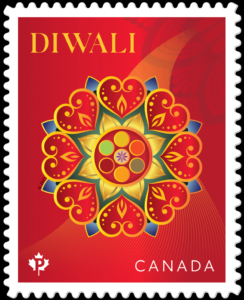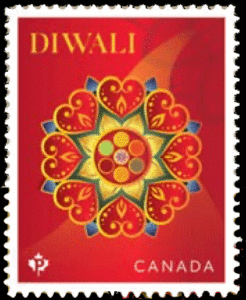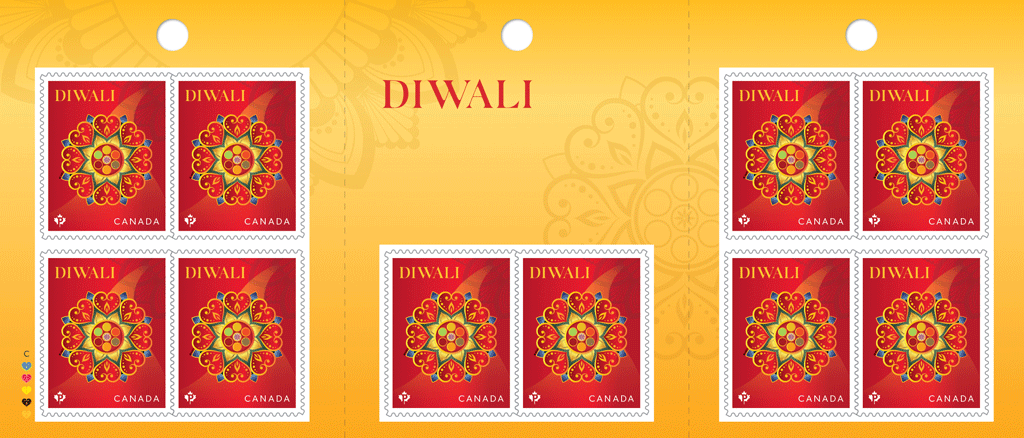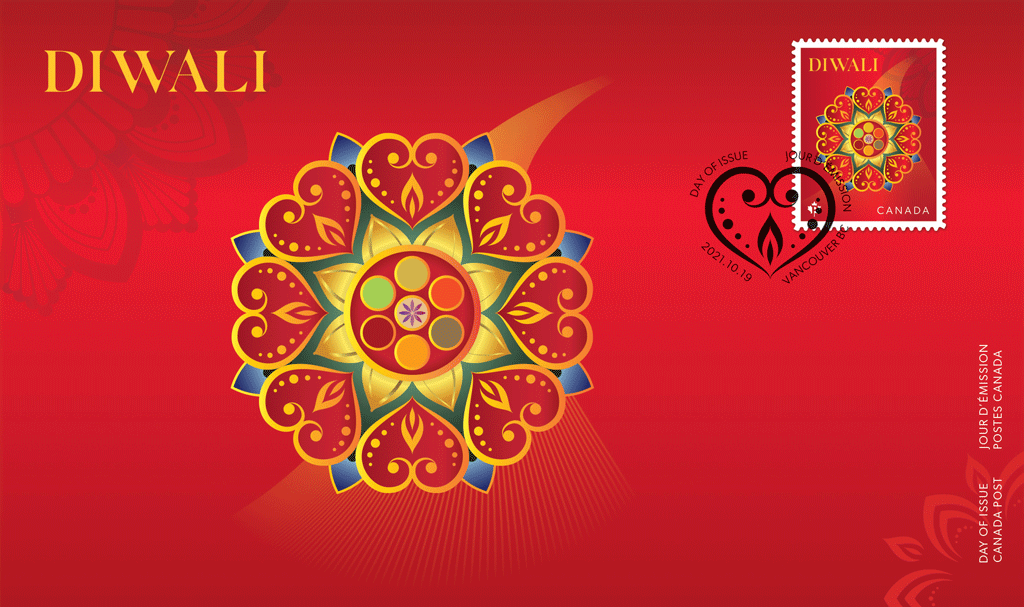Issue date:19 October
Updated October 19th:
[press release]
Intricate pattern on new Diwali stamp welcomes good fortune
VANCOUVER – Today, Canada Post issued a new commemorative stamp to herald the arrival of Diwali – one of the largest and most widely celebrated festivals in India. Observed  by Hindus, Buddhists, Jains, Sikhs and others around the world, the five-day celebration falls on November 4 this year.
by Hindus, Buddhists, Jains, Sikhs and others around the world, the five-day celebration falls on November 4 this year.
About the festival
A time to reflect, overcome negativity, and spread light and love, Diwali is associated with a number of traditions, many of them focused on the triumph of good over evil. Small clay oil lamps called diyas are often lit in rows in homes and temples or set adrift on rivers, fireworks illuminate the sky, and celebrants exchange gifts and donate to those in need.
Rangolis are also an important part of the festival. Drawn on floors in entranceways, living rooms and courtyards using flower petals, coloured sand and other materials, these intricate patterns are intended to invite Lakshmi, the goddess of good fortune, into celebrants’ homes.
About the stamp issue
Designer Seung Jai Paek layered the Rangoli pattern featured on this stamp with meaning. A lotus flower, symbolic of new beginnings, forms both the outline and inset; a ring of heart-shaped diyas expresses love and gratitude; and the Indian spice box (called a masala dabba) in the centre of the design alludes to the food shared during Diwali. Printed by Lowe-Martin, the stamp issue includes a booklet of 10 Permanent™ domestic rate stamps and an Official First Day Cover.
The Diwali stamps and collectibles are available at canadapost.ca and post offices across Canada starting today.
en Francais:
Le motif élaboré du nouveau timbre célébrant Diwali invite à la bonne fortune
VANCOUVER – Aujourd’hui, Postes Canada a émis un nouveau timbre commémoratif pour souligner l’arrivée de Diwali, l’une des fêtes les plus importantes et les plus célébrées  en Inde. Observée par les hindous, les bouddhistes, les jaïns, les sikhs et d’autres communautés dans le monde, la célébration de cinq jours commencera le 4 novembre cette année.
en Inde. Observée par les hindous, les bouddhistes, les jaïns, les sikhs et d’autres communautés dans le monde, la célébration de cinq jours commencera le 4 novembre cette année.
À propos de Diwali
Associée à bon nombre de traditions, dont plusieurs célèbrent le triomphe du bien sur le mal, Diwali est l’occasion de réfléchir, de surmonter la négativité et de remplir le monde de lumière et d’amour. De petites lampes à l’huile, appelées diyas, sont souvent allumées en rangées dans les maisons et les temples ou mises à la rivière, pendant que des feux d’artifice illuminent le ciel et que les gens échangent des cadeaux et font des dons aux personnes dans le besoin.
Les rangolis sont aussi un aspect important des célébrations. Tracés au sol dans les entrées, les salons et les cours à l’aide de pétales de fleurs, de sable coloré ou autre, ces motifs élaborés sont créés dans l’intention d’inviter Lakshmi, la déesse de la bonne fortune, dans les maisons des fidèles.
À propos du timbre
Le designer Seung Jai Paek a savamment superposé des motifs pour créer le rangoli illustré sur ce timbre. La fleur de lotus, qui symbolise les nouveaux débuts, forme le contour et l’intérieur; le cercle de diyas en forme de cœur représente l’amour et la gratitude; et la boîte à épices indiennes (appelée masala dabba), au centre du motif, rappelle le partage de nourriture lors des festins de Diwali. Imprimée par Lowe-Martin, cette émission comprend un carnet de 10 timbres PermanentsMC au tarif du régime intérieur et un pli Premier Jour officiel.
Le timbre et l’article de collection sur Diwali sont en vente dès aujourd’hui à postescanada.ca et dans les bureaux de poste partout au pays.
From Details magazine:
Layers of symbolism are woven into the eye-catching Rangoli pattern on this stamp heralding the arrival of Diwali on November 4. A time to reflect, overcome negativity, and  spread light and love, the five-day festival is observed by Hindus, Buddhists, Jains, Sikhs and others around the world.
spread light and love, the five-day festival is observed by Hindus, Buddhists, Jains, Sikhs and others around the world.
Rangolis are an important part of the celebrations. Drawn on floors in entranceways, living rooms and courtyards using flower petals, coloured sand and other materials, these temporary works of art are traditionally created to invite Lakshmi, the goddess of good fortune, into celebrants’ homes.
Seung Jai Paek studied hundreds of Rangolis before devising this clever concept to convey the spirit of Diwali. A lotus flower, symbolic of new beginnings, forms both the outline and inset of the Rangoli. A ring of heart-shaped lamps or diyas, commonly lit during the festival, expresses love and gratitude. In the centre, an Indian spice box called a masala dabba alludes to the food shared during Diwali. The rich golds in the design evoke a sense of wealth, while the stream of light in the background represents the gods illuminating the path to peace and prosperity.






